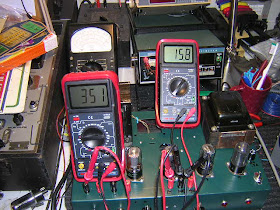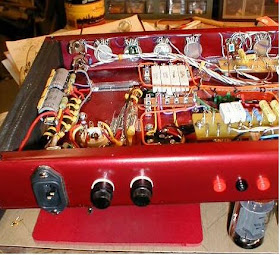


This is a little off the subject of Judybox amps but it may prove useful. I'm a semi pro amp repairman in addition to my other hustles, and I've had 4 or 5 Ampeg SVTs here for work mostly from one music shop. Anyone who's spent any time with the newer generation of SVTs knows a couple of things.
First, there's what I call the "Honey, I've got a headache" system. It consists of a couple of circuits that monitor bias current to the power tubes and allow you to adjust it within a certain range. If the system detects a fault in the power tubes, it throws the amp off line and it can't be gotten out of standby until the fault-perceived or otherwise-is rectified.
The general consensus is "Put in a matched set of power tubes-it may fix the problem, it may not." Of course, for a sextet of 6550s or KT88s, you're going to drop a minimum of $160 for the privilege of finding out whether you're right or wrong-maybe.
Why maybe? Because there are four separate integrated circuits in the system, a thermistor and a couple of relays, too-any one of which can produce faults in the system-not to mention the 220 ohm screen resistors on the tube circuit board. In such instances a set of tubes will only do damage to your billfold.
And thereby hangs a tale.
There is no longer such a thing as a good reliable 6550 tube in existence. Of the four makers in existence-Reflektor, Svetlana, JJ, and Shuguang-none are close to the reliability and ruggedness of the old GE or Tung Sol products. Couple that with the SVT's penchant for running the tubes damned hard, and you have a recipe for regular problems. I realized a while ago that if I was going to do any work on SVTs I had to have a good way of evaluating and classing power tubes.
Thus the Jack Price tube matcher, for which a schematic, layout and bill of materials can be found at the old Priceless Amp Restoration website.
A tube matcher's a handy thing to have, but just like Jack I found that the commercial items like the Maxi matcher were awful pricey. The Maxi matcher also tests at only two voltages, 325v and 400v. That's not nearly enough when today's guitar and bass amps are pushing hard-the SVT slams the power tubes with about 660v.
I figured I had the parts to build it, so I started on it a couple months ago.
My tube matcher is based on the Jack Price schematic but with several differences. The chassis was from a Bogen PA amp I had. I sold the transformers out of it and netted $25 so I was ahead before I started.
The filament transformer was donated from an organ that was running about 40 12AU7s so it has ample capacity. It runs at about 6.7 v unloaded and with 3 6550s and an EL34 powered up it only drops to about 6.4v. There's a 330 volt center tapped winding as well but I figure that was a power supply for a field coil speaker.
The power transformer came from an auction I went to in Ames, Iowa some years ago. There was an old split window Dodge van back behind the mobile radio shop that was closing and it was full of Thordarson stuff and rodent droppings. I bought a pickup load of the heavy stuff for a Franklin and this was in it. It's a Thordarson 26R35 television power transformer which is rated at 275 ma plate current and has 400v on either leg. The B+ ended up being 550v at 120v, and with the variac I can up that some.
Because the Thordarson transformer had no bias winding I had to set it up a la Marshall JTM45 off one side of the high voltage winding. It required a little tinkering to get the resistances right but I can now get anywhere from 7 to 100v negative. It's got about half a dozen 5V and 6v windings that I didn't use except for one for the pilot light.
I had most of the other parts in house-tube sockets, hardware, pop rivets, spray paint, and the only thing I bought was a big bag of terminal strips from some guy on ebay.
I had a 3 amp variac in the garage that I used to power the power transformer-it's a good way of adjusting the B+ to where you like it, bringing it up carefully as you go. I start down at about 300v and ramp it up slowly while monitoring the bias current on one tube for excursions and alarms.
I went to test it last night and promptly blew all four fuses. What I'd forgotten was that bias voltage is inversely proportional to bias current, and when I thought I was turning it down it was going up. POW!
After reviewing my buildup and checking everything I tried it again, new .5 a fuses, with the bias control in mid span and it worked fine. I've got four 6V6s on test at about 350v in the picture. I chose not to use the 4 position selector as it was easy enough to bring the test points out to binding posts. I also tested a set of TAD 6L6GCs that were alleged to be matched-and they are, within 2 or 3 ma at 450v.
This is a relatively easy project to build even if you buy the transformers and a chassis enclosure commercially. If you tinker with amps at all it is well worth the effort.
UPDATE: After I completed this project I started evaluating a pair of 6550s and a pair of KT88s that I borrowed from a friend. Things were fine up to a certain point and then my multimeters would all get hysterical and I'd have to dump the voltage. I turned on an AM radio in the shop and it was clear that what was happening was oscillation. Dave Bane of DB Electronics suggested I incorporate some plate load resistors, which I did, and I also added a few snubbers here and there. It's all good and works fine. I've revised the Price schematic which is attached.

















